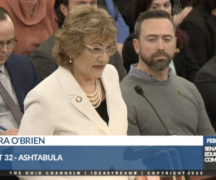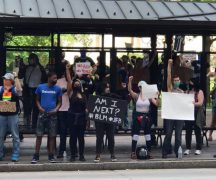It was only minutes after state legislators ended their Zoom conference meeting, with many urging a swift reopening of the economy, that the Ohio Department of Health announced a new slate of virus deaths and illnesses.
Fifteen more Ohioans had died in the prior 24 hours. An additional 363 people were confirmed to have the new coronavirus — more people than could fit in an entire field-level section to watch the Ohio State Buckeyes football team.
And yet, there is a growing momentum among some Ohio legislators to speed up the return to normalcy.
Members of the newly-formed Economic Recovery Task Force within the Ohio House of Representatives held a virtual meeting on Monday. The main message presented by legislators, most of them Republicans, was that Ohio should reopen the economy sooner rather than later. Members also heard from health care professionals who collectively spoke about the increasing harm of not being able to provide care to Ohioans.
The task force is meant to help “lay the foundation for economic recovery from the COVID-19 pandemic,” a news release announcing the group stated last week. It is led by Rep. Paul Zeltwanger, R-Mason, who also chairs the Ohio House’s Economic and Workforce Development Committee.
Zeltwanger said a response to the pandemic depends on how you interpret the data. The United States now has the most total deaths due to COVID-19 in the world, Zeltwanger acknowledged, but he also noted the U.S. does not have as high of deaths per capita as in other countries:
“Let me state it again, and you don’t have to answer, just think about it. Which headline is correct the U.S. leads the world in COVID-19 deaths or US has lowest per capita death rate of top nine countries I’l just go to the answer, Both correct. It’s how you look at the data. and how you present information. I would really challenge all of us to really dig in hard because these are really serious decisions we’re trying to help with.”
Republican State Rep. Nino Vitale offered his own interpretation of the data. The Urbana legislator said he had a “difficult time” assessing the severity of the ongoing pandemic, claiming there are people dying with symptoms of COVID-19 who are included as having directly died as a result of the virus.
As of Monday, lab tests confirmed 268 Ohioans have died due to COVID-19. Another six are believed to be caused by the virus by health providers, but their cause of death is not fully certain.
The state tracks the confirmed cases and the “probable” cases separately on the state’s COVID-19 page commonly used by reporters and citizens alike to track the latest updates.
In Vitale’s mind, though, the state health department experts are only “guessing”:
“When we have to make sure the data coming in is very accurate… one of the things we’ve heard is that the Ohio Department of Health has put out advisories that if you think a patient is presenting with COVID-19 and dies they are categorized as a COVID-19 patient and that to me is troubling because I have a difficult time assessing what’s really going on in my state or any individual county if we are, basically what I would call, and I don’t mean to sound crass, we’re guessing, we’re making an assumption.”
Among the few voices of caution during the virtual meeting was Rep. Terrence Upchurch. The Democrat represents Cuyahoga County, which has 200 times as many confirmed cases as Vitale’s home of Champaign County — 1,197 to just six. (Cuyahoga County also has nearly 16 times as many cases as Zeltwanger’s home of Warren County: 1,197 to 76.)
“Seems to be one consistent theme, that we want to get businesses back open and get back to normal,” Upchurch said. “However, I have to say, if we were to do that sooner rather than later, we would still make ourselves vulnerable to an increase in infections, especially as we talk about the lack of adequate testing across the state of Ohio.”
He asked the three medical professionals to speak about the potential of increased spread by reopening the state too quickly.
Dr. Ian Thompson, a surgeon from Springfield, said the eventual application of “rapid testing” will be a major breakthrough. Such tests could provide results within minutes, allowing doctors to treat patients for issues unrelated to the virus so long as they test negative upon arriving for an appointment or procedure.
The two other guests were Dr. Philip Slonkowski, a pediatric dentist from rural Western Ohio, and Dr. Steven Tornik, an osteopathic doctor who said 10 patients of his family practice just outside of Columbus have contracted the virus. (Nine have since recovered and the 10th is on their way, Tornik told legislators.)
All three outlined major impacts to the statewide shutdown, which has included a pause on non-essential, in-person medical care. Thompson described complications to halting patients’ physical therapy treatments, which may lead to further complications down the road. Slonkowski said his dental practice, now entering its fourth week of closure, is starting to receive calls from families complaining that kids’ teeth are hurting without access to care.
The dentist said his office now has a rapidly-growing backlog of operations and “preventative checks” that will be difficult to manage once the practice reopens. The ongoing shutdown will prove even more harmful to children with braces, Slonkowski said.
“Delaying the treatment means teeth will be moving in directions that are unsupervised,” he said, noting some with braces are ordinarily seen every few weeks.
Slonkowski said it is up to state professionals with the Ohio State Medical Association and the Ohio Dental Association to plan ahead in supplying the reopened health care offices with enough personal protection equipment (PPE). Without the PPE, he said, the offices cannot function safely and patients may not feel comfortable returning for care.
The three professionals, along with most on the task force, recognized the need for Gov. Mike DeWine and Dr. Acton’s shutdown orders. Still, they warned about the resulting consequences as each week passes without a “return to normal.”
Zeltwanger said legislators will need to assist the state government in making the tough decisions to steer Ohio back on course.
The Economic Recovery Task Force is made up of 24 members of the Ohio House of Representatives, all chosen by Speaker of the House Larry Householder, R-Glenford.
Women and Democrats are underrepresented in the group:
- Women make up 28% of the Ohio House, but just four members (17%) of the task force are women.
- Democrats make up 38% of the Ohio House, but just seven members (29%) of the task force are Democrats.
The task force is meeting again Tuesday to hear from several state economic leaders about how the pandemic has affected restaurants, hotels and salons.
***
More from Ohio Capital Journal:
Controlling Board approves nearly $250M in funding for Ohio ventilators, summer lunches, other efforts
The state of Ohio’s Controlling Board approved the distribution of millions of dollars in federal funding Monday to purchase medical masks and help schools with summer lunches, among other things.
In its Monday meeting, the board, made up of members of the Office of Budget and Management and legislators from the House and Senate, cleared the way for the build-out of hospitals as needed during the coronavirus fight, and the purchase and distribution of 2,000 ventilators and five million N95 masks desperately needed by medical professionals.
The funding approved was more than $248 million, with $174 million from federal coronavirus aid for the Ohio Coronavirus Relief Fund. READ MORE
Pandemic highlights gaps in internet access
WASHINGTON — Lawmakers are urging congressional leaders to prioritize emergency funding for high-speed internet access in upcoming coronavirus relief legislation.
More than two dozen lawmakers sent a bipartisan letter last week asking Democratic and Republican leaders of the U.S. House and Senate to set aside funding for a temporary emergency relief fund at the Federal Communications Commission (FCC) that would help small broadband providers continue service for students and low-income families. Ohio Republican U.S. Rep. Troy Balderson of Zanesville signed the letter. READ MORE





